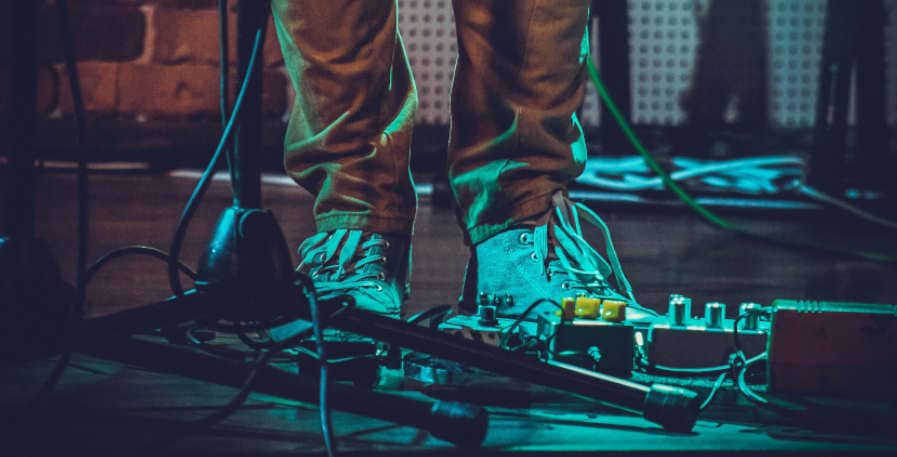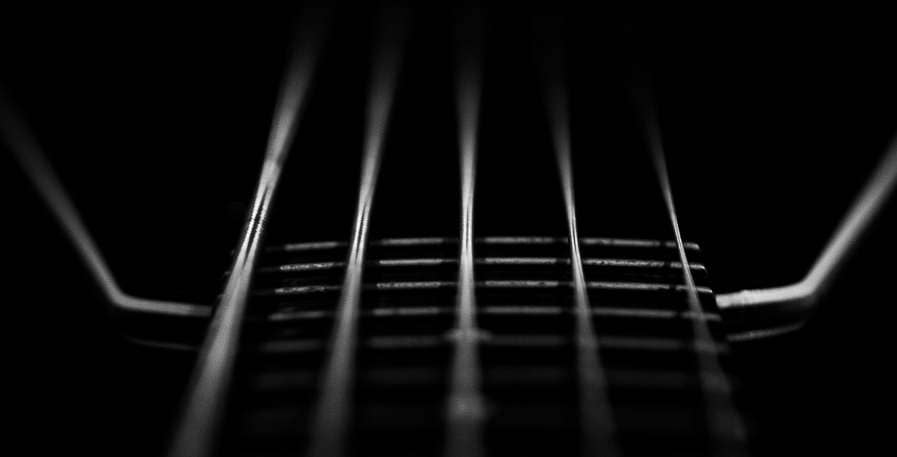This post contains affiliate links
In recent times, it has become more and more common for bassists to make their basses sound like guitars. Generally, this is done to make the sound of their band more fleshed out, or to fill the role of a bassist and rhythm guitarist at the same time.
But given that these are two distinct instruments, can a bass guitar sound like an electric guitar?
While a bass cannot replicate the sound of an electric guitar with 100% accuracy, it can get extremely close. When using an octave and a distortion pedal as well as lighter strings and a pick, the bass is hard to discern from a guitar for most listeners.
So there are a couple of steps you need to take in order to make this work. Some of it comes down to technique and playstyle, but for the most part, it depends on gear.
Therefore, I`ve written this article to show you exactly how you can make your bass sound like a guitar. We will go over the essential pedals that are needed to make this work, as well as what strings to use and why they matter.
I`ll also show you how to incorporate chords into your playing, and how to avoid some of the common pitfalls bassists make when trying to emulate guitar chords.
Octave Pedal
The opening guitar riff on “Seven Nation Army” by The White Stripes is often mistaken for a bass riff. This is because an octave pedal was used to shift the pitch down to make the guitar sound like a bass. In the same vein, an octave pedal can be used to shift the pitch of a bass up to make it resemble a guitar.
The standard tuning for basses is exactly 1 octave lower than that of guitars. Thus, an octave pedal will give you exactly the same range as a guitar, minus the 2 extra strings.
Related reading: 10 reasons why people choose bass over guitar.
Depending on what octave pedal you use, it might sound somewhat synthetic. You might also experience a slight delay as you play the note. Thus, while all octave pedals that can shift the pitch up will work, their quality can differ greatly.
Thus, for making your bass sound like a guitar specifically, my recommendation is this Octave Pedal from Donner. This is because it enables you to shift the pitch of your bass an octave down or up and allows you to adjust both the dry and wet output.
On its own, the octave pedal won`t turn your bass into a guitar. However, it will start to work wonders once you take some additional steps, which leads us to our next point.

Distortion Pedal
I`ve witnessed several people listen to Cliff Burton’s bass parts on early Metallica records and say “Wait, that`s a bass!?”. While there are several factors that made Cliff`s sound unique, a lot of it can be attributed to the use of distortion.
This is because distortion is used to warp the sound of a bass, making the tone heavier and noisier. So even if guitars and basses sound fundamentally different, this added effect blurs this line between the two instruments and makes them sound more alike.
While the effect is a staple in metal and hard rock, slight distortion can also fit well into pop, indie, and hip-hop as well. Thus, adding a bit of distortion can make your bass sound more like a guitar, while fitting within a multitude of genres.
You can use any type of distortion pedal for this purpose. It`s even common for bassists to use distortion pedals intended for guitars. While pedals differ in quality, they are for the most part similar in the type of effect they have on your tone.
If you don`t have one, my recommendation is to get the AZOR Heavy Metal. It`s a simplistic and affordable pedal that aims for the type of distortion that is found in classic metal and rock. This is perfect for making a bass sound like a guitar, as the pedal is designed to emulate a well-known type of guitar tone.
Play with a pick
While some claim that the bass should only be played with your fingers, the 5 most commercially successful bassists all play with a pick.
More importantly, playing with a pick will make your tone sharper. This will make it more resemblant to that of a guitar than if you were to use your fingers.
The average bass pick is 0.046″(1.17mm), while guitar picks are 0.035″ (0.89mm). Because of this difference in thickness bass and guitar picks differ in sound. Therefore, I recommend playing with a guitar pick or at least choosing a bass pick that is on the thinner side.
For some, the thickness of bass strings can make playing with a guitar pick feel cumbersome. This is because the strings will resist the pick to a certain degree, which will make the pick bend slightly as you play.
This will not strictly make your bass harder to play, but it can take a little bit of time to get used to.
It`s worth noting here that Duff McKagan used a 0.73mm pick while providing consistent grooves for Guns N` Roses. Not only did he prove that an extra thin guitar pick can be used to play the bass, but you can also get an excellent and unique tone by using one.

Use thinner strings
A regular set of strings for a 4-string bass has gauges of .105-.050. 6-string guitars, on the other hand, have string gauges of .046-.010. Thus, using thinner strings for your bass will get you closer to the sound of a guitar.
There are two main approaches to choosing strings to make your bass sound more like a guitar:
Switching to slightly lighter bass strings
With this approach, you stay in your current tuning. This way you can still fill the role of a bass player by providing low-end in a band.
By switching to slightly lighter strings, you can however make your tone thinner and more resemblant to that of a guitar. This also makes it easier for your to incorporate chords, as they will not sound as muddy.
You can`t go too light on the strings though, as they will need to retain a playable tension. If the strings are too thin they will feel sloppy to play, and their sound will be clunky.
Therefore, I recommend a light set of .095-.040 strings for this purpose. This is a super light set of strings for a bass, but not excessively so to the point of not being unplayable.
The set I have linked above is a roundwound set with nickel-plated steel from D’Addario. As guitarists most commonly use roundwound strings too, this set will give you a similarly bright tone for your bass.
Tuning an octave higher
Another approach is to get a set of strings that have similar gauges to that of the guitar. This will require you to tune your bass an octave up, which means it will be tuned the same way as the 4 heaviest strings on a guitar.
Strings with these gauges are called piccolo strings. Here is a quick demonstration of what they sound like by Charles Berthoud:
The advantage of Piccolo strings is that you can play at the pitch of a guitar instead of a bass. This has a similar effect as using an octave pedal to shift the pitch up.
The downside is that you are giving up your low-end completely. In a band, this can be solved by a different instrument filling the low end.
Alternatively, you can use piccolo strings in conjunction with an octave pedal when you need to fill in bass frequencies. If you go this route, I recommend this .052-.020 set from DÀddario.
Choose the right chords
Bass players do play chords, but they generally pick them one note at a time. Strummed bass chords can add punch to songs, but they can also quickly ruin the whole sound of a band when used incorrectly.
When trying to emulate the guitar, there are two main ways to play chords on the bass:
1. Deep chords
The upside of utilizing low chords is that you can take up a lot of space in the mix. This can assist in making your sound more fleshed out, especially in a band with only 1 guitar player.
It is however crucial to find a fitting tone that isn`t too low-end heavy to make this work. Bass chords can sound muddy when played too low. Thus, finding a fitting tone and writing fitting parts can be challenging when incorporating low chords.
Les Claypool of Primus is an example of a bassist who goes about this the right way. There are countless Primus basslines where he incorporates deep chords into bass grooves. One example of this is the catchy line on “John The Fisherman”:
2. High Chords
As shown in my chart of bass chords, playing chords high up on the neck ensures that your basslines don`t sound too muddy. However, this creates a new problem in that it becomes harder to provide enough low-end for your band.
One way to solve this is by having a different instrument cover the lower frequencies. For example, you might play the bass like a guitar, while the keyboard plays the bass part.
Another solution is to neglect the lack of low-end. While this can make your band sound hollow, it can also work well when done sparingly. A great example of this is The Red Hot Chili Peppers’ “Snow (Hey Oh)”, where Flea`s bassline is made up of high chords during the chorus.
Conclusion
The bass and electric guitar are vastly different instruments. However, it is possible to blur the line between them to the point where most people won`t be able to tell which is which.
By using an octave pedal or a set of Piccolo strings, you can play an octave higher. This enables you to play at the same pitch as guitar players do.
Adding distortion can greatly shift the sound of any instrument. Adding this effect to a bass while it`s played at the same pitch as the guitar makes it difficult to tell which instrument is being played.
This effect becomes even more accentuated when playing with a pick. This is because your tone will sound sharp like a guitar, rather than smooth and warm like a bass that`s played with your fingers.
By incorporating chords into your basslines or by playing chord progressions, you can take on the role of a rhythm guitarist on the bass. Both low and high chords have their pros and cons, so make sure you know what you are sacrificing when you use them.
By following all of the steps above, you will make your bass sound like a guitar in no time. As a result, any band that you play is never going to sound hollow or lack energy ever again.
A common technique for guitarists, but less so for bassists, are pinch harmonics. Learning how to do them can further elevate your playing, and make you sound even more like a guitarist. To learn more, read my guide on pinch harmonics on the bass

